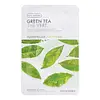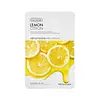What's inside
What's inside
 Key Ingredients
Key Ingredients

 Benefits
Benefits

 Concerns
Concerns

 Ingredients Side-by-side
Ingredients Side-by-side

Water
Skin ConditioningGlycerin
Humectant1,2-Hexanediol
Skin ConditioningPanthenol
Skin ConditioningSodium Hyaluronate
HumectantDimethicone
EmollientXanthan Gum
EmulsifyingCarbomer
Emulsion StabilisingParfum
MaskingGlycereth-26
HumectantAllantoin
Skin ConditioningPersea Gratissima Fruit Extract
EmollientMethyl Glucose Sesquistearate
EmollientOryza Sativa Extract
AbsorbentPEG-60 Hydrogenated Castor Oil
EmulsifyingAlcohol Denat.
AntimicrobialTheobroma Cacao Seed Extract
AntioxidantNelumbium Speciosum Flower Extract
Skin ConditioningButyrospermum Parkii Butter
Skin ConditioningLaminaria Japonica Extract
Skin ProtectingBetaine
HumectantCyclopentasiloxane
EmollientPropanediol
SolventCitrus Paradisi Fruit Extract
Skin ConditioningPunica Granatum Fruit Extract
AntioxidantOlea Europaea Fruit Extract
BleachingEthylhexylglycerin
Skin ConditioningCalendula Officinalis Flower Extract
MaskingTrisodium EDTA
Acrylates/C10-30 Alkyl Acrylate Crosspolymer
Emulsion StabilisingCamellia Sinensis Leaf Extract
AntimicrobialSolanum Tuberosum Pulp Extract
SmoothingCaprylic/Capric Triglyceride
MaskingDipropylene Glycol
HumectantBambusa Vulgaris Extract
Skin ConditioningTrehalose
HumectantLecithin
EmollientButyrospermum Parkii Butter Extract
Skin ConditioningPentaerythrityl Tetraethylhexanoate
EmollientHoney Extract
HumectantCucumis Sativus Fruit Extract
EmollientPanax Ginseng Root Extract
EmollientHydrogenated Lecithin
EmulsifyingPotassium Hydroxide
BufferingAloe Barbadensis Leaf Extract
EmollientGanoderma Lucidum Extract
Skin ProtectingPhenoxyethanol
PreservativeCitrus Limon Fruit Extract
MaskingMelaleuca Alternifolia Leaf Extract
PerfumingPhaseolus Radiatus Seed Extract
Skin ConditioningVaccinium Angustifolium Fruit Extract
Skin ProtectingButylene Glycol
HumectantDisodium EDTA
Tromethamine
BufferingWater, Glycerin, 1,2-Hexanediol, Panthenol, Sodium Hyaluronate, Dimethicone, Xanthan Gum, Carbomer, Parfum, Glycereth-26, Allantoin, Persea Gratissima Fruit Extract, Methyl Glucose Sesquistearate, Oryza Sativa Extract, PEG-60 Hydrogenated Castor Oil, Alcohol Denat., Theobroma Cacao Seed Extract, Nelumbium Speciosum Flower Extract, Butyrospermum Parkii Butter, Laminaria Japonica Extract, Betaine, Cyclopentasiloxane, Propanediol, Citrus Paradisi Fruit Extract, Punica Granatum Fruit Extract, Olea Europaea Fruit Extract, Ethylhexylglycerin, Calendula Officinalis Flower Extract, Trisodium EDTA, Acrylates/C10-30 Alkyl Acrylate Crosspolymer, Camellia Sinensis Leaf Extract, Solanum Tuberosum Pulp Extract, Caprylic/Capric Triglyceride, Dipropylene Glycol, Bambusa Vulgaris Extract, Trehalose, Lecithin, Butyrospermum Parkii Butter Extract, Pentaerythrityl Tetraethylhexanoate, Honey Extract, Cucumis Sativus Fruit Extract, Panax Ginseng Root Extract, Hydrogenated Lecithin, Potassium Hydroxide, Aloe Barbadensis Leaf Extract, Ganoderma Lucidum Extract, Phenoxyethanol, Citrus Limon Fruit Extract, Melaleuca Alternifolia Leaf Extract, Phaseolus Radiatus Seed Extract, Vaccinium Angustifolium Fruit Extract, Butylene Glycol, Disodium EDTA, Tromethamine
Water
Skin ConditioningGlycerin
HumectantCitrus Medica Limonum Fruit Extract
Skin ConditioningButylene Glycol
HumectantAlcohol Denat.
AntimicrobialBetaine
HumectantSodium Hyaluronate
HumectantXanthan Gum
EmulsifyingHydrogenated Lecithin
EmulsifyingDimethicone
EmollientPhaseolus Radiatus Extract
Skin ConditioningBetula Platyphylla Japonica Bark Extract
Skin ConditioningRumex Crispus Root Extract
Skin ConditioningCarbomer
Emulsion StabilisingPEG-60 Hydrogenated Castor Oil
EmulsifyingTriethanolamine
BufferingParfum
MaskingWater, Glycerin, Citrus Medica Limonum Fruit Extract, Butylene Glycol, Alcohol Denat., Betaine, Sodium Hyaluronate, Xanthan Gum, Hydrogenated Lecithin, Dimethicone, Phaseolus Radiatus Extract, Betula Platyphylla Japonica Bark Extract, Rumex Crispus Root Extract, Carbomer, PEG-60 Hydrogenated Castor Oil, Triethanolamine, Parfum
 Reviews
Reviews

Ingredients Explained
These ingredients are found in both products.
Ingredients higher up in an ingredient list are typically present in a larger amount.
Alcohol Denat. is an alcohol with a denaturant property. It is created by mixing ethanol with other additives.
This ingredient gets a bad rep because it is irritating and drying - mostly due to its astringent property. Astringents draw out natural oils in tissue, constricting pores and leaving your skin dried out.
However, alcohol denat. is not all that bad.
Due to its low molecular weight, alcohol denat. tends to evaporate quickly. One study on pig skin found half of applied alcohol evaporated in 10 seconds and less than 3% stayed on skin.
This also helps other ingredients become better absorbed upon application.
Studies are conflicted about whether this ingredient causes skin dehydration. One study from 2005 found adding emollients to propanol-based sanitizer decreased skin dryness and irritation. Another study found irritation only occurs if your skin is already damaged.
Small amounts of alcohol are generally tolerated by oily skin or people who live in humid environments.
The rule of thumb is if this alcohol is near the end of an ingredients list, it will probably not affect your skin much.
Also...
This ingredient has antimicrobial and solvent properties.
The antimicrobial property helps preserve products and increase their shelf life. As a solvent, it helps dissolve other ingredients.
Other types of astringent alcohols include:
Learn more about Alcohol Denat.Betaine is a common humectant (a substance that promotes retention of moisture). It's known to be gentle on the skin and can help balance hydration.
This ingredient is best for improving hydration and soothing irritated skin. Studies also show it helps even out skin tone.
Fun fact: Betaine is naturally created in the skin and body. The kind found within cosmetic products can be either plant-derived or synthetic.
Another name for betaine is trimethylglycine.
Learn more about BetaineButylene Glycol (or BG) is used within cosmetic products for a few different reasons:
Overall, Butylene Glycol is a safe and well-rounded ingredient that works well with other ingredients.
Though this ingredient works well with most skin types, some people with sensitive skin may experience a reaction such as allergic rashes, closed comedones, or itchiness.
Learn more about Butylene GlycolCarbomer is a polymer of acrylic acid. Its main role is to create a gel consistency.
A high amount of carbomer can cause pilling or balling up of products. Don't worry, most products contain 1% or less of carbomer.
Dimethicone is a type of synthetic silicone created from natural materials such as quartz.
What it does:
Dimethicone comes in different viscosities:
Depending on the viscosity, dimethicone has different properties.
Ingredients lists don't always show which type is used, so we recommend reaching out to the brand if you have questions about the viscosity.
This ingredient is unlikely to cause irritation because it does not get absorbed into skin. However, people with silicone allergies should be careful about using this ingredient.
Note: Dimethicone may contribute to pilling. This is because it is not oil or water soluble, so pilling may occur when layered with products. When mixed with heavy oils in a formula, the outcome is also quite greasy.
Learn more about DimethiconeGlycerin is already naturally found in your skin. It helps moisturize and protect your skin.
A study from 2016 found glycerin to be more effective as a humectant than AHAs and hyaluronic acid.
As a humectant, it helps the skin stay hydrated by pulling moisture to your skin. The low molecular weight of glycerin allows it to pull moisture into the deeper layers of your skin.
Hydrated skin improves your skin barrier; Your skin barrier helps protect against irritants and bacteria.
Glycerin has also been found to have antimicrobial and antiviral properties. Due to these properties, glycerin is often used in wound and burn treatments.
In cosmetics, glycerin is usually derived from plants such as soybean or palm. However, it can also be sourced from animals, such as tallow or animal fat.
This ingredient is organic, colorless, odorless, and non-toxic.
Glycerin is the name for this ingredient in American English. British English uses Glycerol/Glycerine.
Learn more about GlycerinHydrogenated Lecithin is created from the hydrogenation of lecithin (a group of phospholipids). Hydrogenation is a chemical reaction between hydrogen and another element.
This ingredient is an emollient and emulsifier. As an emollient, it helps soften skin by trapping moisture within. As an emulsifier, it prevents oil and water ingredients from separating.
Parfum is a catch-all term for an ingredient or more that is used to give a scent to products.
Also called "fragrance", this ingredient can be a blend of hundreds of chemicals or plant oils. This means every product with "fragrance" or "parfum" in the ingredients list is a different mixture.
For instance, Habanolide is a proprietary trade name for a specific aroma chemical. When used as a fragrance ingredient in cosmetics, most aroma chemicals fall under the broad labeling category of “FRAGRANCE” or “PARFUM” according to EU and US regulations.
The term 'parfum' or 'fragrance' is not regulated in many countries. In many cases, it is up to the brand to define this term.
For instance, many brands choose to label themselves as "fragrance-free" because they are not using synthetic fragrances. However, their products may still contain ingredients such as essential oils that are considered a fragrance by INCI standards.
One example is Calendula flower extract. Calendula is an essential oil that still imparts a scent or 'fragrance'.
Depending on the blend, the ingredients in the mixture can cause allergies and sensitivities on the skin. Some ingredients that are known EU allergens include linalool and citronellol.
Parfum can also be used to mask or cover an unpleasant scent.
The bottom line is: not all fragrances/parfum/ingredients are created equally. If you are worried about fragrances, we recommend taking a closer look at an ingredient. And of course, we always recommend speaking with a professional.
Learn more about ParfumPeg-60 Hydrogenated Castor Oil comes from hydrogenated castor oil. It is a solubilizer and emulsifier.
As a solubilizer, it helps dissolve ingredients into a water-based version. It is also an emulsifer. Emulsifier help prevent oils and water from separating. Both these properties help create evenly-spread and uniform products.
Basically, Peg-60 Hydrogenated Castor Oil helps hold ingredients together.
Learn more about PEG-60 Hydrogenated Castor OilSodium Hyaluronate is hyaluronic acid's salt form. It is commonly derived from the sodium salt of hyaluronic acid.
Like hyaluronic acid, it is great at holding water and acts as a humectant. This makes it a great skin hydrating ingredient.
Sodium Hyaluronate is naturally occurring in our bodies and is mostly found in eye fluid and joints.
These are some other common types of Hyaluronic Acid:
Learn more about Sodium HyaluronateWater. It's the most common cosmetic ingredient of all. You'll usually see it at the top of ingredient lists, meaning that it makes up the largest part of the product.
So why is it so popular? Water most often acts as a solvent - this means that it helps dissolve other ingredients into the formulation.
You'll also recognize water as that liquid we all need to stay alive. If you see this, drink a glass of water. Stay hydrated!
Learn more about WaterXanthan gum is used as a stabilizer and thickener within cosmetic products. It helps give products a sticky, thick feeling - preventing them from being too runny.
On the technical side of things, xanthan gum is a polysaccharide - a combination consisting of multiple sugar molecules bonded together.
Xanthan gum is a pretty common and great ingredient. It is a natural, non-toxic, non-irritating ingredient that is also commonly used in food products.
Learn more about Xanthan Gum